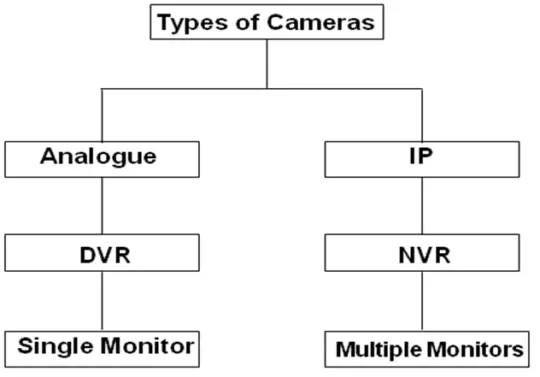CCTV Security Systems is one and only Security System that gives its utility before and as well as after the unlikely event, which means it not only deters intrusion and prevent any unlikely event to happen but also comes handy after the incident during post event analysis.
Basic Classification of CCTV System

Depending on the technology, budget and applications, all three of above changes drastically. It is not only a Camera that plays major role in giving an edge to the performance of an overall surveillance system, but also other units like channel of signal transmission and recording & live transmission station are also of the utmost importance. A degraded or wrongly chosen Communication System can very easily contribute to hamper the performance of any CCTV Security System in spite of the best of the Cameras being deployed.
To start with the very basics of the CCTV Security Systems: we shall start with the overview of classification of all the three units as mentioned above.
Cameras: They are broadly classified as IP Cameras and Analogue Cameras, where an analogue camera gives video signals in absolute value as continuous waveforms which as a result can be carried to considerable distances, but being an analogue, signals are prone to a lot of attenuation. At larger distances the signal distortion is too much to give clear picture. In such a scenario in spite of the best image resolution and picture quality given by the camera the user is not able to enjoy the same resolution and quality at monitoring station as analogue signals cannot be carried without any distortion.
An IP Camera gives digital signals in the form of high and low pulses, which means there is no absolute value and either a signal is low or high which helps in preventing the distortion of signal. The utility of an IP camera lies in its ability to give signals which can be sent across a LAN/WAN network/internet or any other network where the cameras can be accessed at any place on PC/Mobile/Laptop and the recordings can be stored/analysed even without any proprietary recording device.
Channel of Signal Transmission: Depending on the choice of types of camera the channel for signal transmission is chosen. Standard Video Cables are used if the cameras are analogue camera. On the contrary if the camera is an IP camera or if an encoder is being deployed after the camera, standard cables are used to carry digital signals. For longer distances Optical Fiber Cables are used where first the electrical signals are converted into optical signals with the help other devices and accessories.
Recording or Live Transmission Station: The recording can be done by a DVR (Digital Video Recorder) in case of an Analogue Camera where the DVR also facilitates the live viewing of the cameras at a monitor. Number of channels required in a DVR depends on the number of cameras deployed. However number of monitors has to be one as DVR takes the input from cameras through its various channel ports but it gives one single output to the monitor.
In case of an IP Camera since the cameras are connected in a network there can be as many viewing points as desired. All that is required is to connect the monitors to the network. Similarly recording is also done at a server connected to the network. The amount of cabling reduces drastically in case of IP camera, since all the devices can be connected to a network through a single wire and network switches.



